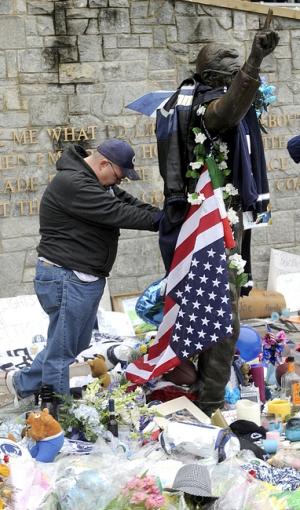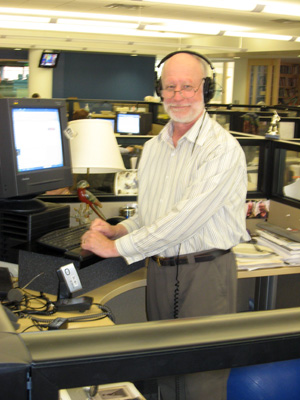What now, Williston; dispatches from the American now, St. Francis’ flag tattoo brouhaha, a cyclist’s blind faith, and the stand-up society.
First this announcement: I’ll be on MPR’s Midmorning this morning as one of several panelists on a roundtable. Midmorning is trying this out in advance of the debut of Kerri Miller’s new show next month. Be sure to call or email your questions about romance, home fix-up projects, and UFOs starting after the news at 9 (CT).
1) WHAT NOW, WILLISTON?
When you’re 24 and life is still an adventure ahead of you, the oil fields of North Dakota might be more exciting than for those trying to carve out a living by leaving family behind and heading for the (black) gold rush. Minneapolis native Andrew Shay is 24, and just got a job with Halliburton in Williston, ND, his mother, Linda, wrote to us yesterday.
Shay is living in a “man camp,” with 500 other men, few of them doing what he’s doing: blogging.
His blog, I Am Here, debuted earlier this month. It’s worth following:
Things are wild here. Everyone’s looking back, or forward; talking about the good days’ or talking about how they are gonna spend their cash when they get home. Every dude that we trained with has been out to the field so far; I think we are some of the last ones to get out. The guys who i trained with offered good advice, and wish me luck; but most of them just say; be safe. And I guess that’s the key; be safe.
wish me luck
BusinessWeek dropped into Williston recently to assess the impact of the oil boom. It found the dreams of local residents for the future of their town are being dashed in a hurry:
Prices for gasoline and groceries in Mountrail and Williams counties — the heart of the boom — are 30 percent higher than in the state’s largest cities. Lines to eat at local restaurants often top an hour. Finding a plumber or a handyman can take weeks and often cost three times as much as it did three years ago.
There were three rapes in the town last summer, 100 kids in the school system are homeless, the roads are crumbling, and the mayor says the city is going backward.
One after another yesterday, officials tried to tell a committee of the North Dakota Legislature to pay more attention to what’s happening:
“Our quality of life is gone. It is absolutely gone,” Williams County Commissioner Dan Kalil said. “My community is gone, and I’m heartbroken. I never wanted to live anyplace but Williston, North Dakota, and now I don’t know what I’m going to do.”
2) DISPATCHES FROM THE AMERICAN NOW
On my commentary segment with Mary Lucia on The Current the other day, I mentioned an idea I had for a more useful State of the Union address. Take 10 or so people from all walks of life and all parts of the country and give them each five minutes to talk to a joint session of Congress about life in the real world.
What would that be like? It’d be like this, as it turns out. Colleagues Jeff Jones, Jeff Severns Guntzel, and Neal Karlen (meet them) of American Public Media’s Public Insight Network, have just unveiled their latest project: Dispatches from the American Now.
They’re interviewing people across the country — a virtual road trip, they’re calling it — not only about what they expect from America, but considering what we expect from each other.
As Karlen puts it:
Maybe like Kerouac on that last page of his book, some of the voices we find will be down on the American dream, believing simply that, “nobody — nobody — knows what’s going to happen to anybody besides the forlorn rags of growing old.”
Others along the way likely will feel the exact opposite — it’s okay to be in that one per cent! Success is a cherished American theme.
And yet others will have mixed feelings about where the American Dream has both failed them and come true. After two weeks reporting from the virtual road, we hope to have a better grasp of the issues facing the folks we meet along the way, and to listen to some voices that haven’t been heard before. Then we’ll let what we hear guide where we go next.
3) THE FLAG TATTOO
Many adults have little knowledge of the American flag code — that’s why we wear American flag ties, and eat off American flag paper plates on July 4th — so is it surprising many kids have no clue?
At a high school in St. Francis, a kid has been suspended because, according to KSTP, he’s wearing a tattoo of the confederate flag below a tattoo of the American flag. Everyone involved in the controversy seems oblivious to the fact a tattoo of the American flag disrespects it, too.
Officials say the tattoo violates the school’s dress code, which is the least of the violations.
“I’m just going to keep wearing what I want to wear and go to school and if the school doesn’t like it then they’ll have to keep suspending me for it,” said Neal Carlson.
Meanwhile, in State College, Pennsylvania, the shrine to the late Joe Paterno is growing. Someone stuck this flag on JoePa’s statue, probably thinking it was a patriotic statement. It wasn’t. There are at least four flagrant violations of the flag code here:

4) A CYCLIST’S BLIND FAITH
Matt Wadsworth has a dream. He is determined to set a world record for distance jumping by clearing 100 feet on his Honda CRF450R motorcycle, Wired.com reports today.
“I’ve loved motorcycles since I was a kid,” Wadsworth says. “I loved the sound of them. Right from as early as I can remember, I used to sit on them in the street and all I wanted was to have a minibike. I was lucky enough to get one when I was six.”
“I think jumping is the hardest thing I’ve ever tried to do. And I have tried to do some pretty difficult stuff. We started with a pretty big jump, but just riding over it slowly. We had to work so hard on going in a straight line and finding ways to do just that. We put rumble strips on the sides of the runway, but that didn’t work because I’d hit the strips and not know whether I should turn left or right. We don’t know until we try it.”
He’s blind.
5) THE STAND-UP SOCIETY

The fad sweeping offices everywhere has old roots, we learn today. More cubicle critters are standing up in the workplace, a practice that goes back to Hemingway. He liked to write standing up.
Now, there are tangible health gains being recognized. In studies, the death rate for those who spent six or more hours a day sitting was significantly higher than for those who sit for three hours or less. That’s true for women more than men, for some reason.
Today, the Star Tribune reports, the Mayo Clinic is also studying whether and why this is the case.
Sitting is sort of the new smoking,” the Mayo Clinic endocrinologist said Wednesday on the eve of an experiment designed to tackle so-called “lifestyle” diseases.
He and a team of researchers from Mayo and the University of Minnesota believe that even modest increases in daily activity could help people lose weight and improve their health — and help control the nation’s staggering health care bills.
Levine, who walks on a treadmill while he works and believes in “walking staff meetings,” said similar studies have suggested that employees can burn up to 350 additional calories per day, reduce their health care costs and perform better at work by replacing 2 1/2hours of sitting with standing each day.
What else can make you sick by sitting at work? Work.
NPR reports on a new study in Britain showing working long hours increases depression.
All the people in the study were white-collar workers in the civil service, so it’s a pretty small snapshot of the working world. Those working longer hours were more likely to be men in higher-level job grades. They were also more likely to be married or living with someone, and likely to drink more than they should.
Sounds almost like a British version of Don Draper, the hard-drinking ad exec at the center of the AMC series Mad Men.
The correlation between long working hours and depression didn’t come to light until the researchers adjusted their data to level out income. That’s a standard statistical technique to try to determine the effect of different factors. “In terms of prevention, revealing the relevance of long working hours as a risk factor among high-[socio-economic status] employees who otherwise have lower risk of depression seems important,” the researchers write.
Bonus: Finalmente, Ricky! Ricky Rubio in GQ.
TODAY’S QUESTION
After he promised to establish a moon base by the end of his second term as president, Newt Gingrich responded to earlier suggestions that he was grandiose. He said that “Americans are instinctively grandiose because we believe in a bigger future.” Today’s Question: Is grandiosity an appealing characteristic in a president?
Midmorning (9-11 a.m.) – First hour: The Roundtable with panelists: Tim Nelson, MPR News reporter; Bob Collins, writer the NewsCut blog for MPR News; Dane Smith, president of Growth and Justice. He spent 30 years as a reporter with the Star Tribune and the Pioneer Press; Ben Golnik, founder and principal of Golnik Strategies, a political consulting firm.
Second hour: Winter home repair.
Midday (11 a.m. – 1 p.m.) – First hour: The week in politics with political panelists Todd Rapp and Maureen Shaver.
Second hour: Rebroadcast of last night’s GOP presidential debate in Florida.
Talk of the Nation (1-3 p.m.) – First hour: Solar flares and how space weather affects us on Earth.
Second hour: Where science is done without secrecy. Plus, the first use of embryonic stem cells to restore sight.
All Things Considered (3-6:30 p.m.) – The iPhone is a hot seller in both the U.S. and China. But not all American products are such a big hit over there. That’s what Kraft Foods found out when the company brought the Oreo to China.

